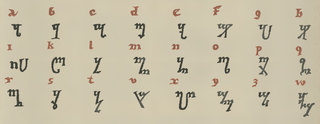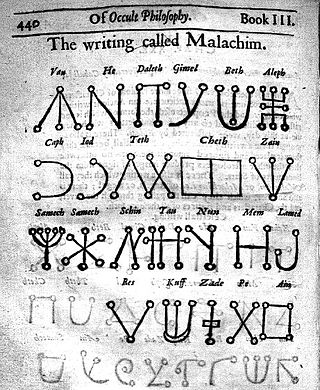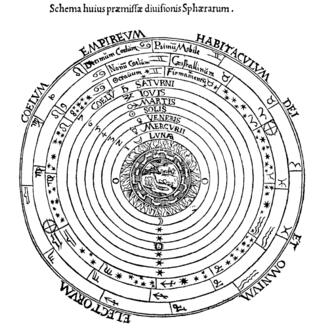
Gematria is the practice of assigning a numerical value to a name, word or phrase by reading it as a number, or sometimes by using an alphanumerical cipher. The letters of the alphabets involved have standard numerical values, but a word can yield several values if a cipher is used.

Heinrich Cornelius Agrippa von Nettesheim was a German Renaissance polymath, physician, legal scholar, soldier, knight, theologian, and occult writer. Agrippa's Three Books of Occult Philosophy published in 1533 drew heavily upon Kabbalah, Hermeticism, and neo-Platonism. His book was widely influential among esotericists of the early modern period, and was condemned as heretical by the inquisitor of Cologne.
This article contains information about the literary events and publications of 1531.

An elemental is a mythic supernatural being that is described in occult and alchemical works from around the time of the European Renaissance, and particularly elaborated in the 16th century works of Paracelsus. According to Paracelsus and his subsequent followers, there are four categories of elementals, which are gnomes, undines, sylphs, and salamanders. These correspond to the four Empedoclean elements of antiquity: earth, water, air, and fire, respectively. Terms employed for beings associated with alchemical elements vary by source and gloss.

There have been various attempts at the classification of demons within the contexts of classical mythology, demonology, occultism, and Renaissance magic. These classifications may be for purposes of traditional medicine, exorcisms, ceremonial magic, witch-hunts, lessons in morality, folklore, religious ritual, or combinations thereof. Classifications might be according to astrological connections, elemental forms, noble titles, or parallels to the angelic hierarchy; or by association with particular sins, diseases, and other calamities; or by what angel or saint opposes them.

Three Books of Occult Philosophy is Heinrich Cornelius Agrippa's study of occult philosophy, acknowledged as a significant contribution to the Renaissance philosophical discussion concerning the powers of magic, and its relationship with religion. The first book was printed in 1531 in Paris, Cologne, and Antwerp, while the full three volumes first appeared in Cologne in 1533.
The Sworn Book of Honorius is a medieval grimoire purportedly written by Honorius of Thebes. The Latin word juratus, which is typically translated "sworn", is intended to mean "oathbound". It was allegedly the grimoire of Pope Honorius I, hence its name.

The pigpen cipher is a geometric simple substitution cipher, which exchanges letters for symbols which are fragments of a grid. The example key shows one way the letters can be assigned to the grid.

The Theban alphabet, also known as the witches' alphabet, is a writing system, specifically a substitution cipher of the Latin script, that was used by early modern occultists and is popular in the Wicca movement.

Malachim was an alphabet published by Heinrich Cornelius Agrippa in the 16th century. Other alphabets with a similar origin are the Celestial Alphabet and Transitus Fluvii.

The Celestial Alphabet, also known as Angelic Script, is a set of characters described by Heinrich Cornelius Agrippa in the 16th century. It is not to be confused with John Dee and Edward Kelley's Enochian alphabet, which is also sometimes called the Celestial alphabet. Other alphabets with a similar origin are Transitus Fluvii and Malachim.

Divine language, the language of the gods, or, in monotheism, the language of God, is the concept of a mystical or divine proto-language, which predates and supersedes human speech.
De occulta philosophia may refer to:
Liber Aleph vel CXI: The Book of Wisdom or Folly is the title of The Equinox, volume III, number VI, by Aleister Crowley. The book is written in the form of an epistle to his magical son, Charles Stansfeld Jones, Frater Achad, whom Crowley later doubted as being his true magical son, asserting that Achad had in fact gone insane, citing as evidence Achad's "upending the tree of life" in his Q.B.L., or The Bride's Reception, the first of Achad's major qabalistic works.
John French (1616–1657) was an English physician known for his contributions to chemistry as well as for his English translations of Latin and German works.
Shem HaMephorash, meaning "the explicit name," is originally a Tannaitic term describing the Tetragrammaton. In Kabbalah, it may refer to a name of God composed of either 4, 12, 22, 42, or 72 letters, the latter version being the most common.

In astrology, certain stars are considered significant. Historically, all of the various heavenly bodies considered by astrologers were considered "stars", whether they were stars, planets, other stellar phenomena like novas and supernovas, or other solar system phenomena like comets and meteors.
Semiphoras and Schemhamphorash is the title of an occult or magic text of Jewish provenance, published in German by Andreas Luppius in 1686. It was based on the earlier Latin text, Liber Semiphoras attributed to Solomon, which Luppius augmented heavily with passages from Agrippa De occulta philosophia and other sources.
English Qaballa (EQ) is a system of Hermetic Qabalah, supported by a system of arithmancy that interprets the letters of the English alphabet via an assigned set of values, discovered by James Lees in 1976. It is the result of an intent to understand, interpret, and elaborate on the mysteries of Aleister Crowley's received text, Liber AL vel Legis, the Book of the Law. According to Jake Stratton-Kent, "the English Qaballa is a qabalah and not a system of numerology. A qabalah is specifically related to three factors: one, a language; two, a 'holy' text or texts; three, mathematical laws at work in these two."
White magic has traditionally referred to the use of supernatural powers or magic for selfless purposes. Practitioners of white magic have been given titles such as wise men or women, healers, white witches or wizards. Many of these people claimed to have the ability to do such things because of knowledge or power that was passed on to them through hereditary lines, or by some event later in their lives. White magic was practiced through healing, blessing, charms, incantations, prayers, and songs. White magic is the benevolent counterpart of malicious black magic.












